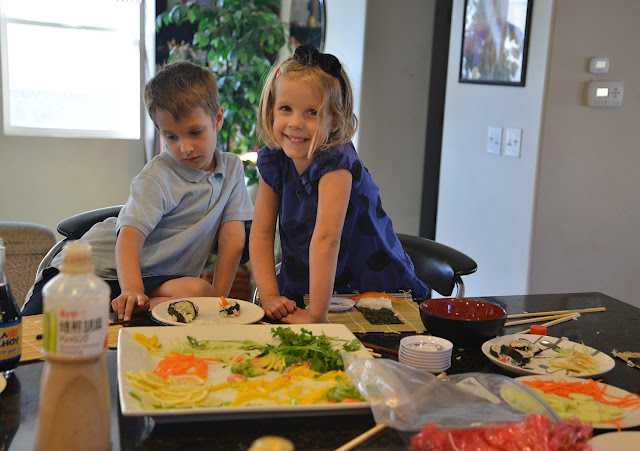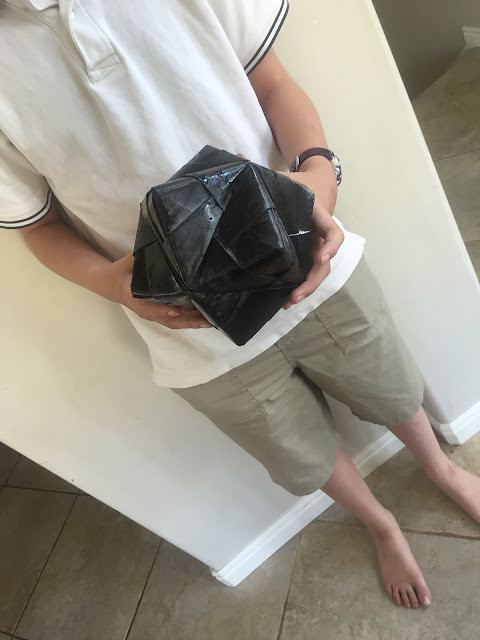Before this unit, I had only tried sushi a few times. I liked it okay, but I didn't really…get it. It seemed faintly strange to me, and I worried about the raw fish, but mostly I just didn't see what the fuss was about and I felt like maybe I was missing something.
MAKING our own sushi somehow transformed it into a food that I understood! Putting all the components together myself made me realize how many variations in taste and texture sushi can utilize, and I realized that "sushi" wasn't just one thing, but a whole class of food that could be adjusted to suit almost any taste. It just suddenly made sense.
I think the other thing that helped me understand it was just seeing in videos how carefully and lovingly Japanese chefs prepared their sushi. I saw what an art form it was and began to appreciate the visual and creative elements. Two videos we really liked were this one on the
history of sushi, and this
Begin Japanology episode on sushi. And then seeing, in those same videos, people
enjoying and relishing their sushi so greatly, helped me get over the hump of feeling like it was a strange food, and just feel more like, "Wow, so many people like this and think it's delicious…
I want to try it too!"
Oh—and it also helped when I learned that each piece of sushi was supposed to be eaten in one bite. I can't always manage that, of course, but I think the first few times I had sushi I just felt so awkward eating it, because it fell apart or I couldn't quite get it with the chopsticks. But when I looked at each piece as an entity meant to go together, where all the flavors were supposed to join and make one multi-layered taste, I was more willing to just stuff it into my mouth and enjoy that deep blend of flavor. And not worry about if it was messy or if I looked silly. :)
The children didn't have any preconceived notions about sushi, but they loved all the other Japanese food we'd tried, and they had seen all the same videos where it was made to look so delicious, so they were all excited to try it. Their absolute favorite thing, though, was this video we watched about
conveyor belt sushi restaurants in Japan. They LOVED the idea of getting your food from a conveyor belt, right at your table! It's too bad we don't have restaurants like this around here because they would have been overcome with joy to go to one.

Failing a conveyor belt restaurant, though, making our own sushi was the next best thing, because everyone could prepare theirs just as they liked it. We had our friends the Rhodes come over and help us. They had mats for us to use for rolling, and Carrie Ann brought the most beautiful platter of fillings (is that what they're called?). Mango, cucumber, carrot, lemon, lime, avocado, cilantro, cream cheese. She arranged them into darling little fish and turtle shapes, which is so Japanese in spirit. It was perfect. I got our fish, tuna and salmon, from a Market Street Grill (restaurant) and had no concerns about its quality, and once I tasted how delicious it was in the sushi, I wasn't concerned about it being raw, either. It was so great to have the Rhodes with us because they knew what they were doing, and helped show us so we could feel confident too.

The rice was easy to make. We used what was called "sushi rice" at our grocery store. Before cooking it, I made sure to rinse it several times until the water was clear, and I followed the directions on the package, which were a little different than the usual 2:1 water to rice ratio. (It was 2 cups water to 1 1/2 cups rice.) Then Carrie Ann told me to add, for every two cups of uncooked rice, add 1 T. sugar and 2 T. rice vinegar. I made two double batches of rice, one in the rice cooker and one on the stovetop, and I thought both were equally good.
So, for future reference (because we will definitely be doing this again), let me write out the recipe as I made it:
Sushi Rice
4 cups water
3 cups rice
1 1/2 T. sugar
3 T. rice vinegar
Rinse rice several times in a colander over a bowl. Then drain excess water so you're left with just rice. Place rice in rice cooker or in saucepan. Add 4 c. water to the rice. Stir in sugar and vinegar. Bring to a boil; cook, covered for 20 minutes (on stove) or as directed for rice cooker.
 |
| Malachi looks so sad, but I think he is just concentrating intently |
Rolling the sushi was the best part. It was so fun to choose what combinations of things to put into your roll. I loved the salmon and the tuna, and I loved the bright flavor of the thin thin slices of lemon. Next time I want to perfect our sauces even more, but even the simple soy-sauce based sauces we made were quite good.
 |
| Todd was the best with the children. They ALL needed help at once, and he was always there to give it. Whereas I kept saying, "Just a minute, I'm making my OWN right now!" |
We made some rice balls too, but I think everyone liked the sushi best. Seb arranged his plate with meticulous care, as we had learned how attentive the Japanese are to their food presentation.
Making our own sushi was also great because it allowed us to share the rolls really easily, and try a whole bunch of different combinations. There wasn't anything I didn't like. Everything was SO tasty!

















































